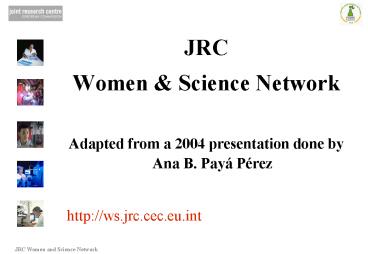JRC - PowerPoint PPT Presentation
1 / 15
Title: JRC
1
- JRC
- Women Science Network
- Adapted from a 2004 presentation done by Ana B.
Payá Pérez
http//ws.jrc.cec.eu.int
2
- Contents
- Why this Network
- Mission
- What do they do ?
- Gender balance status - JRC
- Do they have made progress ?
- Action Plan for 2004
3
Why the network ?
- Response to the Commission Communication
COM(1999)76-C5-0103 on Women and Science -
Mobilizing women to enrich European research - gt goal of reaching 40 women
- Commission Reform 1st May 2004
- preference to women senior appointments
- staff regulations related to maternity and
parental leave - New Community Framework on GE (2001-2005)
- European Research Area
- knowledge of causes for under representation.
- specific needs of women in research activities
4
The official mission
This network has been established in April 2000
by JRC Director General
- to implement the Commission recommendations into
the JRC - to help in attaining gender balance targets into
the JRC - to understand the gender issues inside the JRC
5
Where?
Representatives
6
Representatives from all JRC institutes and
directorates.
Ana B. Paya-Pérez (IHCP) (Chairman) Geraldine
Barry (DSS) and Vera Calenbuhr (DSS) Piedad
García de la Rasilla (BSS) Catherine Simoneau
(IHCP) Birgit Christiansen (ITU) and Maria
Betti (ITU) Constantina Filou (IE) and Elsa
Conceicao (IE) Anna-Stiina Heiskanen (IES) and
Pam Kennedy (IES) Greet Janssens-Maenhout (IPSC)
and Matina Halkia (IPSC) Fabiana Scapolo (IPTS)
and Paola Di Pietrogiacomo (IPTS) Josephine
McCourt (IRMM) and Berit Sejeroe-Olsen
(IRMM) Veronique Deneville (DPRM) and Carina Røhl
Søberg (DPRM) Brigitte Landesmann (ISD) and An
Lievens (ISD)
7
What do they do ?
- Provide support to the Director General via
recommendations for implementing Commission
policy at the JRC - Facilitate, development of a fair and effective
working environment (flexible part-time,
tele-working, maternity leave replacement, child
care facilities) - Enhance visibility of female scientists in JRC
- Carry out Specialised surveys on (Scientific
productivity, gender distribution in selection,
equal opportunity inside the JRC, replacement of
women on maternity leave, ) - Disseminate information annual report on Gender
Perspectives in the JRC, JRC WS Web site,
meetings, - Collaborate with DG RDTs Women and Science Unit
FP6
8
Gender balance status - JRC
Statutory scientific and administrative staff in
DG JRC 2003
9
Evolution of the gender representation in
Statutory scientific and administrative staff
(gt2004)
10
Disparities of representation ofJRC senior and
middle management among the Institutes
0/10 directors, 2 advisors/11 and 6 heads of
units/63
11
Gender representation among Cat. 20
Grant-holders (PhD students) and Cat. 30
Grant-holders (Post-docs)
Target 40
Target 40
12
Progress
- Clear positive evolution 1996-2004 annual
growth rate of 10 of women population - Target of 40 representation in grandholders
- Promotion of women from A7,6,5 to A6,5,4
partially achieved - Improvements in the working environment
13
Improving the gender balance at the Joint
Research Centre
Code of Good PracticeMaternity Leave
- Aware of pregnancy? to inform superior
- To establish schedule of deliverables
- Evaluation of type of replacement ?MSU budgetary
possibilities - Replacement
- Before 3 months the maternity leave commences
- After 1 month (at least) return
14
JRC gender analysis demonstrates a considerable
lack of women in most areas of science and
technology in JRC, not only in the various
research activities but also in their
representation on committees etc.Low ratio of
women to men amongst the scientific staff
16Poor representation of women in managerial
(both scientific and administrative) and other
positions of responsibility (110 or lower)Low
representation of women in JRC internal
committeesLow representation of women in JRC
external panels
Progress ? Yes.but...
15
4th Action Programme (2004-2008) Equal
Opportunities for Men and Women at the EC
objectives
- To continue and to further develop a work
culture - To achieve a fair distribution of
responsibilities, ensure that women are involved
in decision-making, - To promote women professional development in all
categories - To better use available talents, to the benefit
of the Commission and its staff.































